
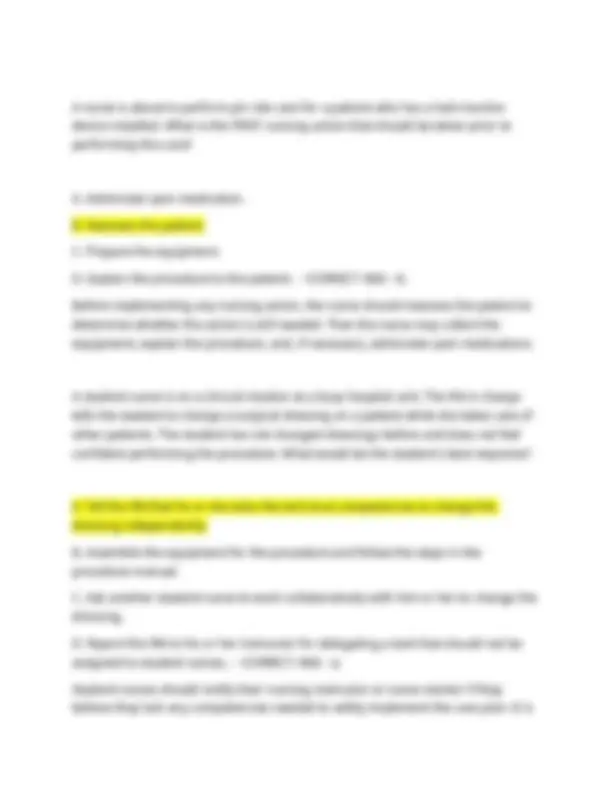
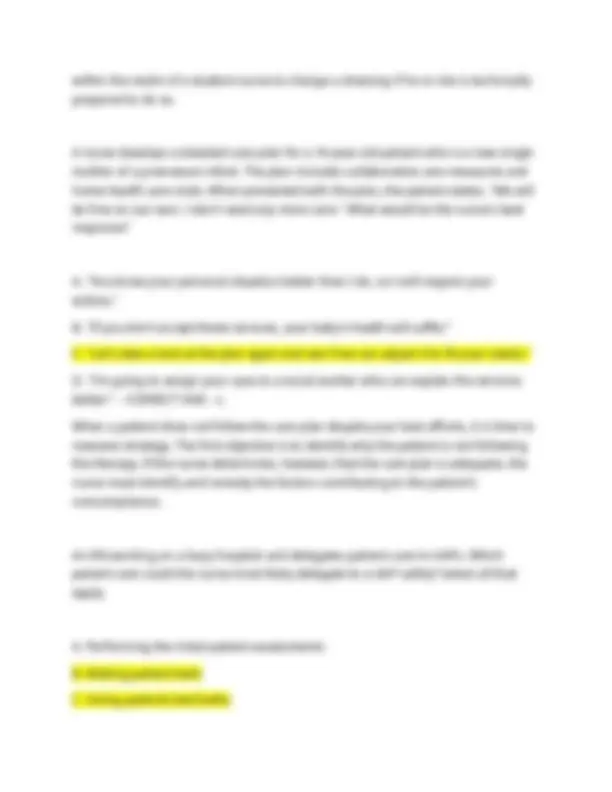
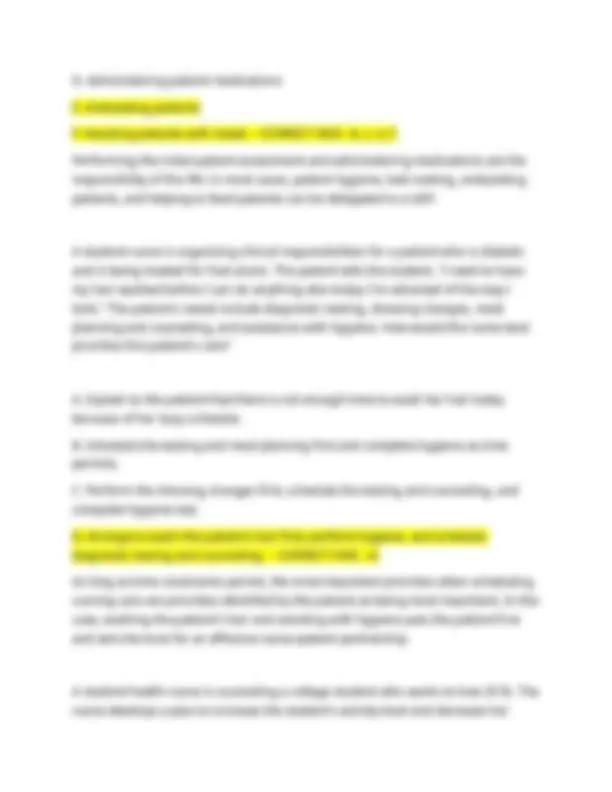
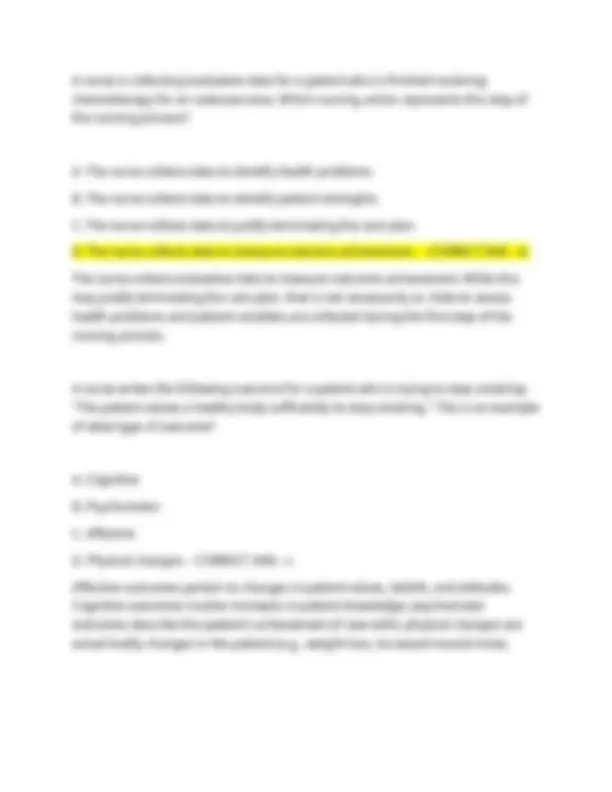
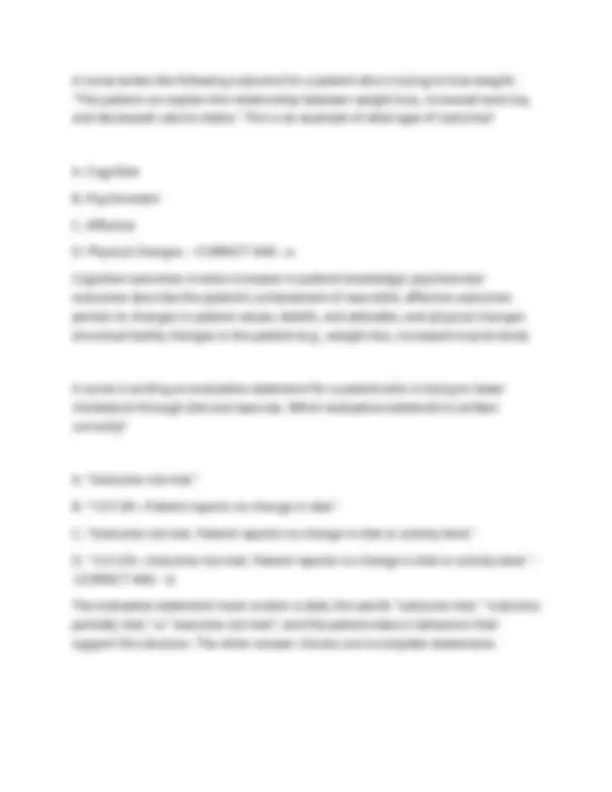
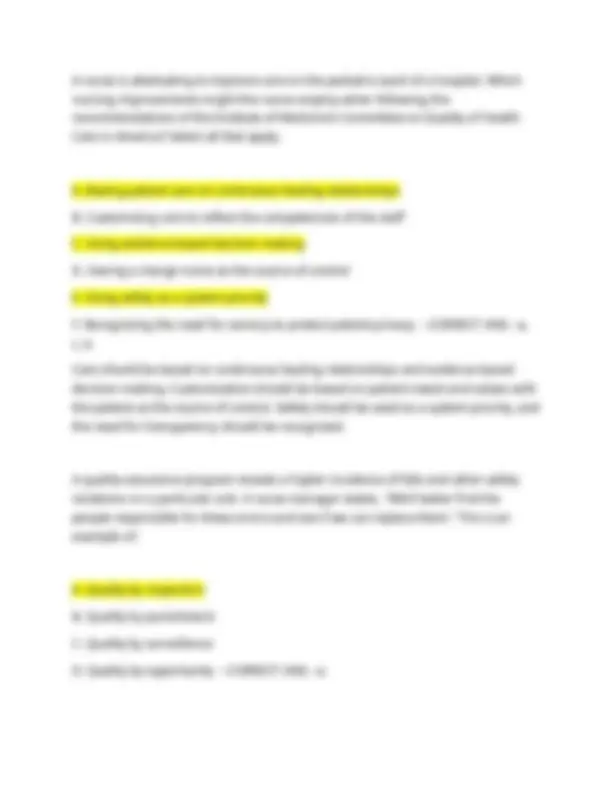
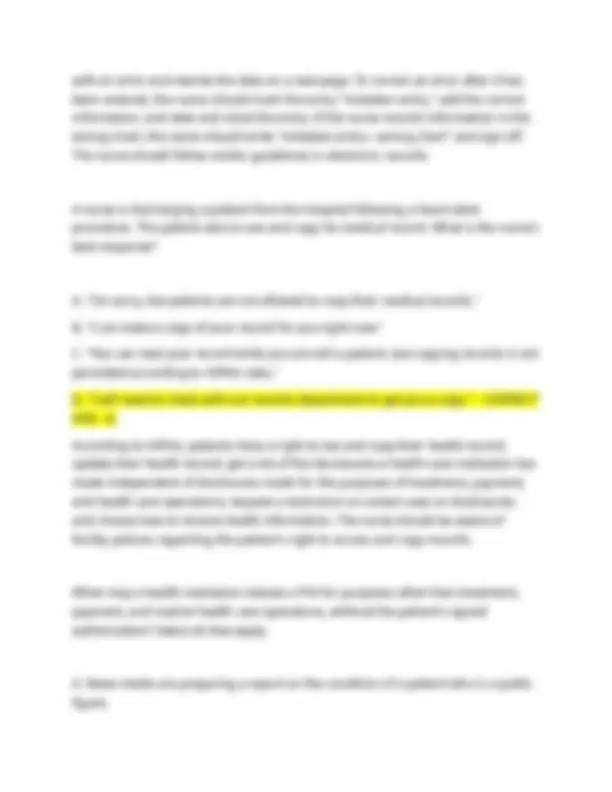
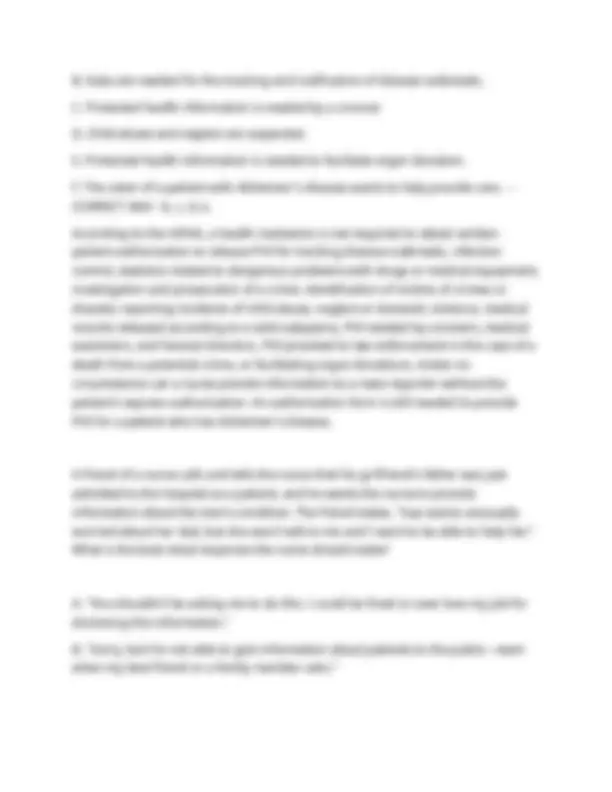
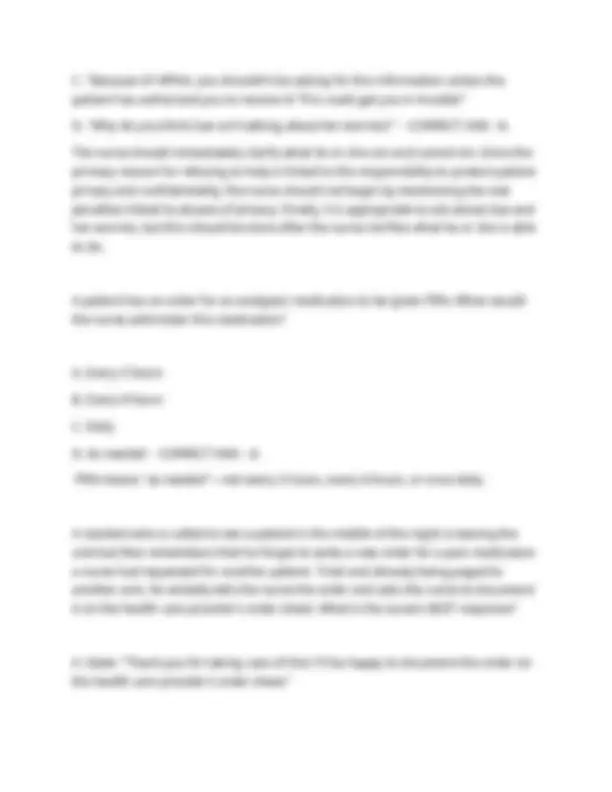
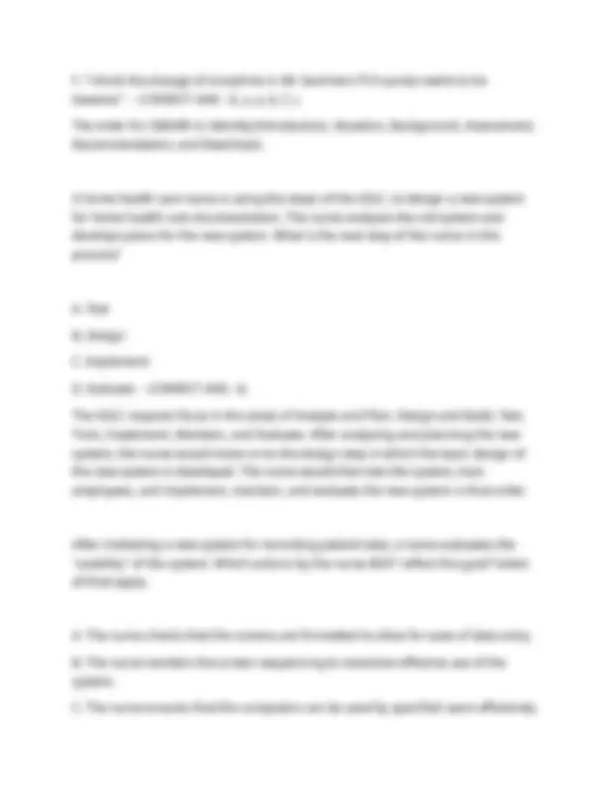
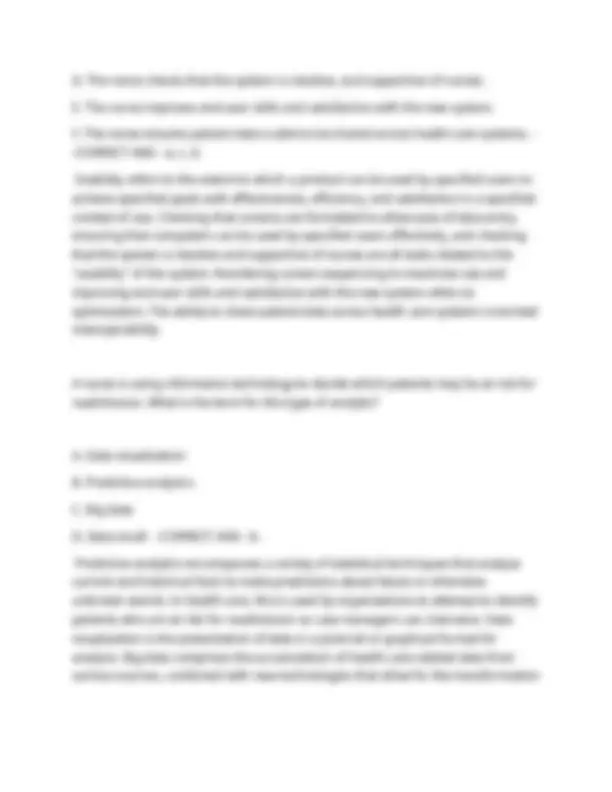
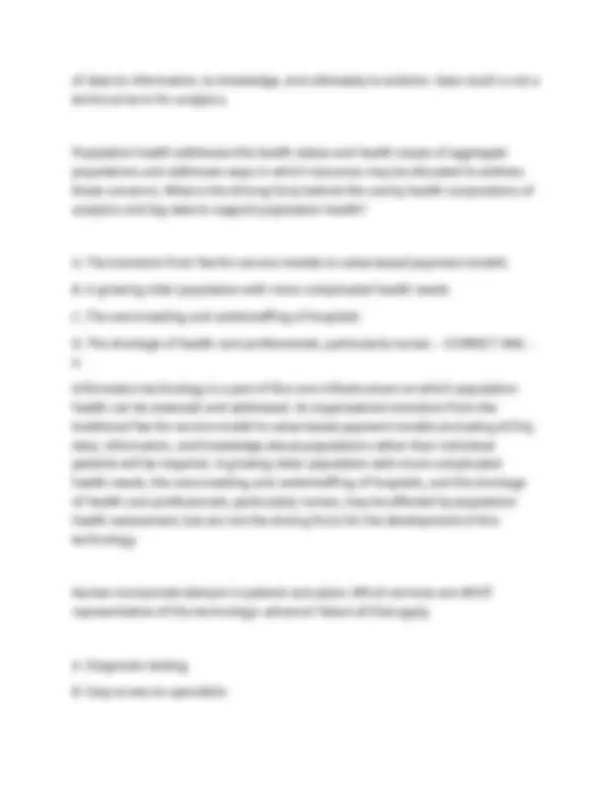
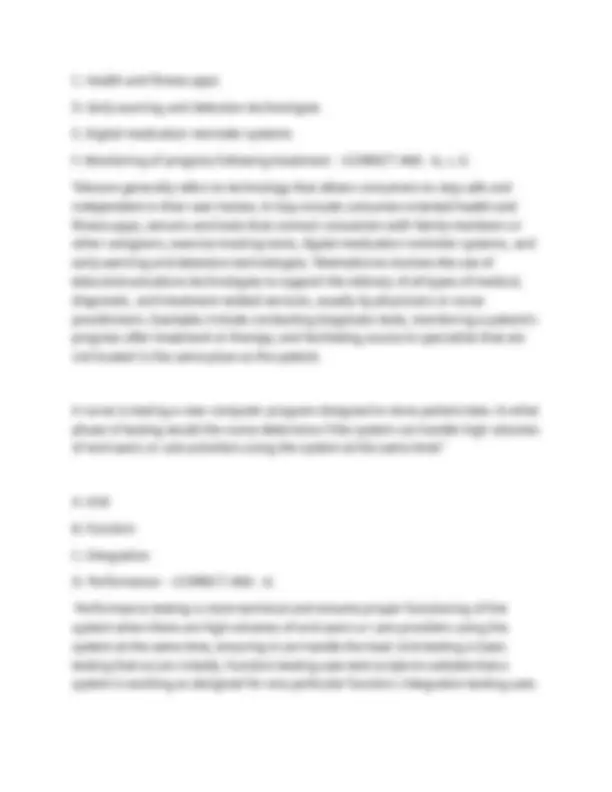
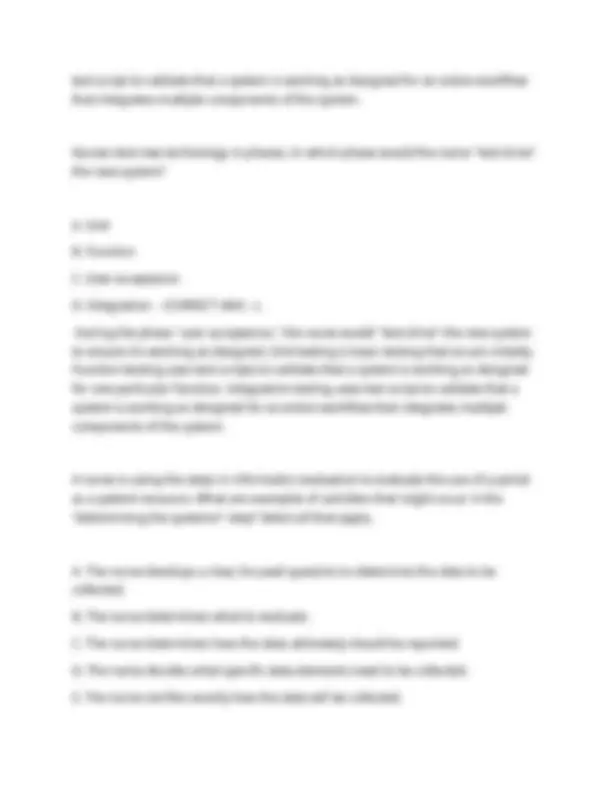
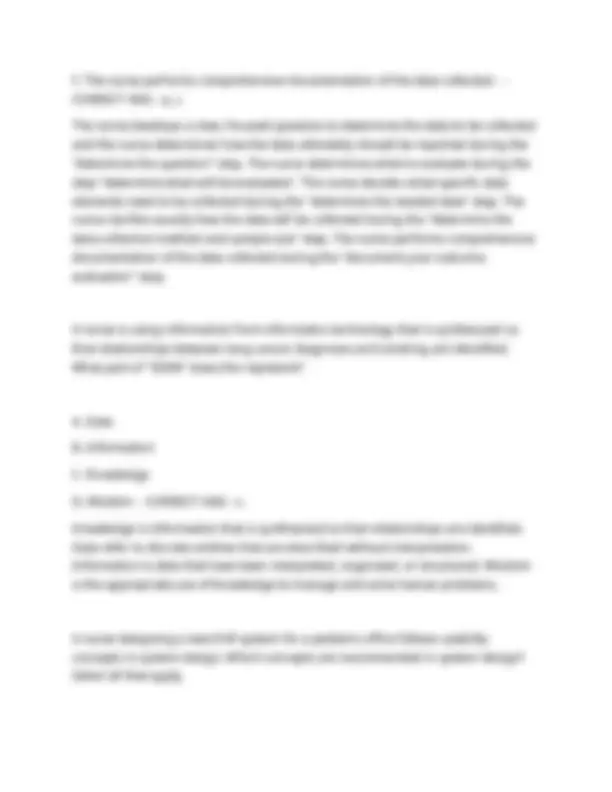
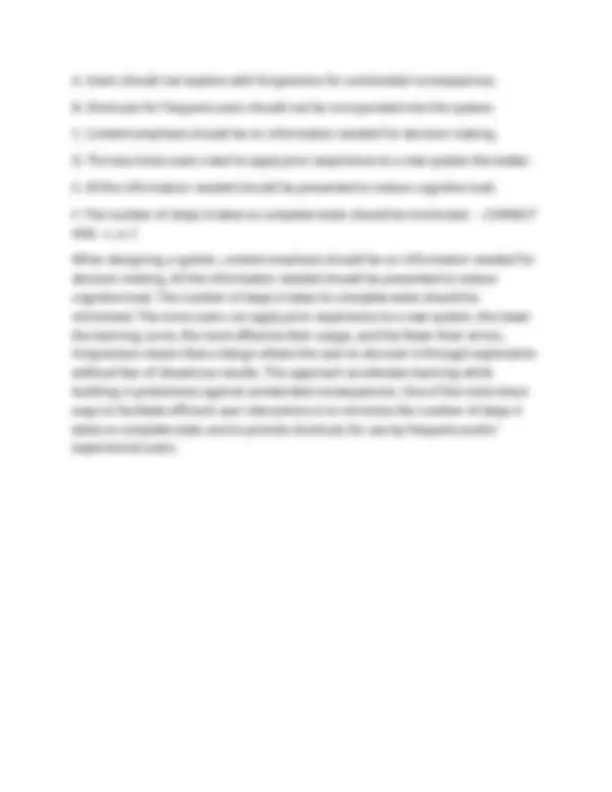


Study with the several resources on Docsity

Earn points by helping other students or get them with a premium plan


Prepare for your exams
Study with the several resources on Docsity

Earn points to download
Earn points by helping other students or get them with a premium plan
Community
Ask the community for help and clear up your study doubts
Discover the best universities in your country according to Docsity users
Free resources
Download our free guides on studying techniques, anxiety management strategies, and thesis advice from Docsity tutors
Mastering Nursing 205: Complete Study Guide with Clinical Case Scenarios, Evidence-Based Practice Insights, and Top Tips for Academic and Practical Success
Typology: Exams
1 / 24

This page cannot be seen from the preview
Don't miss anything!

















Nurses use the NIC Taxonomy structure as a resource when planning nursing care for patients. What information is found in this structure? A. Case studies illustrating a complete set of activities that a nurse performs to carry out nursing interventions B. Nursing interventions, each with a label, a definition, and a set of activities that a nurse performs to carry it out, with a short list of background readings C. A complete list of nursing diagnoses, outcomes, and related nursing activities for each nursing intervention D. A complete list of reimbursable charges for each nursing intervention - - CORRECT ANS- -b. The NIC Taxonomy lists nursing interventions, each with a label, a definition, a set of activities that a nurse performs to carry it out, and a short list of background readings. It does not contain case studies, diagnoses, or charges. A new RN is being oriented to a nursing unit that is currently understaffed and is told that the UAPs have been trained to obtain the initial nursing assessment. What is the best response of the new RN? A. Allow the UAPs to do the admission assessment and report the findings to the RN.
B. Do his or her own admission assessments but don't interfere with the practice if other professional RNs seem comfortable with the practice. C. Tell the charge nurse that he or she chooses not to delegate the admission assessment until further clarification is received from administration. D. Contact his or her labor representative to report this practice to the state board of nursing. - -CORRECT ANS- -c. The nurse should not delegate this nursing admission assessment because only nurses can perform this intervention. The nurse should seek clarification for this policy from the nursing administration. A nurse performs nurse-initiated nursing actions when caring for patients in a skilled nursing facility. Which are examples of these types of interventions? Select all that apply. A. A nurse administers 500 mg of ciprofloxacin to a patient with pneumonia. B. A nurse consults with a psychiatrist for a patient who abuses pain killers. C. A nurse checks the skin of bedridden patients for skin breakdown. D. A nurse orders a kosher meal for an orthodox Jewish patient. E. A nurse records the I&O of a patient as prescribed by his health care provider. F. A nurse prepares a patient for minor surgery according to facility protocol. - - CORRECT ANS- -c, d, f. Nurse-initiated interventions, or independent nursing actions, involve carrying out nurse-prescribed interventions resulting from their assessment of patient needs written on the nursing care plan, as well as any other actions that nurses initiate without the direction or supervision of another health care professional. Protocols and standard orders empower the nurse to initiate actions that ordinarily require the order or supervision of a health care provider. Consulting with a psychiatrist is a collaborative intervention.
within the realm of a student nurse to change a dressing if he or she is technically prepared to do so. A nurse develops a detailed care plan for a 16-year-old patient who is a new single mother of a premature infant. The plan includes collaborative care measures and home health care visits. When presented with the plan, the patient states, "We will be fine on our own. I don't need any more care." What would be the nurse's best response? A. "You know your personal situation better than I do, so I will respect your wishes." B. "If you don't accept these services, your baby's health will suffer." C. "Let's take a look at the plan again and see if we can adjust it to fit your needs." D. "I'm going to assign your case to a social worker who can explain the services better." - -CORRECT ANS- -c. When a patient does not follow the care plan despite your best efforts, it is time to reassess strategy. The first objective is to identify why the patient is not following the therapy. If the nurse determines, however, that the care plan is adequate, the nurse must identify and remedy the factors contributing to the patient's noncompliance. An RN working on a busy hospital unit delegates patient care to UAPs. Which patient care could the nurse most likely delegate to a UAP safely? Select all that apply. A. Performing the initial patient assessments B. Making patient beds C. Giving patients bed baths
D. Administering patient medications E. Ambulating patients F. Assisting patients with meals - -CORRECT ANS- -b, c, e, f. Performing the initial patient assessment and administering medications are the responsibility of the RN. In most cases, patient hygiene, bed-making, ambulating patients, and helping to feed patients can be delegated to a UAP. A student nurse is organizing clinical responsibilities for a patient who is diabetic and is being treated for foot ulcers. The patient tells the student, "I need to have my hair washed before I can do anything else today; I'm ashamed of the way I look." The patient's needs include diagnostic testing, dressing changes, meal planning and counseling, and assistance with hygiene. How would the nurse best prioritize this patient's care? A. Explain to the patient that there is not enough time to wash her hair today because of her busy schedule. B. Schedule the testing and meal planning first and complete hygiene as time permits. C. Perform the dressing changes first, schedule the testing and counseling, and complete hygiene last. D. Arrange to wash the patient's hair first, perform hygiene, and schedule diagnostic testing and counseling. - -CORRECT ANS- -d. As long as time constraints permit, the most important priorities when scheduling nursing care are priorities identified by the patient as being most important. In this case, washing the patient's hair and assisting with hygiene puts the patient first and sets the tone for an effective nurse-patient partnership. A student health nurse is counseling a college student who wants to lose 20 lb. The nurse develops a plan to increase the student's activity level and decrease her
D. 2, 3, 1, 4, 5 - -CORRECT ANS- -c. The five classic elements of evaluation in order are (1) identifying evaluative criteria and standards (what you are looking for when you evaluate—i.e., expected patient outcomes); (2) collecting data to determine whether these criteria and standards are met; (3) interpreting and summarizing findings; (4) documenting your judgment; and (5) terminating, continuing, or modifying the plan. A new nurse who is being oriented to the subacute care unit is expected to follow existing standards when providing patient care. Which nursing actions are examples of these standards? Select all that apply. A. Monitoring patient status every hour B. Using intuition to troubleshoot patient problems C. Turning a patient on bed rest every 2 hours D. Becoming a nurse mentor to a student nurse E. Administering pain medication ordered by the physician F. Becoming involved in community nursing events - -CORRECT ANS- -a, c, e. Standards are the levels of performance accepted and expected by the nursing staff or other health care team members. They are established by authority, custom, or consent. Standards would include monitoring patient status every hour, turning a patient on bed rest every 2 hours, and administering pain medication ordered by the physician. Using intuition to troubleshoot patient problems, becoming a nurse mentor to a student nurse, and becoming involved in community nursing events are not patient care standards.
A nurse is collecting evaluative data for a patient who is finished receiving chemotherapy for an osteosarcoma. Which nursing action represents this step of the nursing process? A. The nurse collects data to identify health problems. B. The nurse collects data to identify patient strengths. C. The nurse collects data to justify terminating the care plan. D. The nurse collects data to measure outcome achievement. - -CORRECT ANS- -d. The nurse collects evaluative data to measure outcome achievement. While this may justify terminating the care plan, that is not necessarily so. Data to assess health problems and patient variables are collected during the first step of the nursing process. A nurse writes the following outcome for a patient who is trying to stop smoking: "The patient values a healthy body sufficiently to stop smoking." This is an example of what type of outcome? A. Cognitive B. Psychomotor C. Affective D. Physical changes - -CORRECT ANS- -c. Affective outcomes pertain to changes in patient values, beliefs, and attitudes. Cognitive outcomes involve increases in patient knowledge; psychomotor outcomes describe the patient's achievement of new skills; physical changes are actual bodily changes in the patient (e.g., weight loss, increased muscle tone).
A nurse is attempting to improve care on the pediatric ward of a hospital. Which nursing improvements might the nurse employ when following the recommendations of the Institute of Medicine's Committee on Quality of Health Care in America? Select all that apply. A. Basing patient care on continuous healing relationships B. Customizing care to reflect the competencies of the staff C. Using evidence-based decision making D. Having a charge nurse as the source of control E. Using safety as a system priority F. Recognizing the need for secrecy to protect patient privacy - -CORRECT ANS- -a, c, e. Care should be based on continuous healing relationships and evidence-based decision making. Customization should be based on patient needs and values with the patient as the source of control. Safety should be used as a system priority, and the need for transparency should be recognized. A quality-assurance program reveals a higher incidence of falls and other safety violations on a particular unit. A nurse manager states, "We'd better find the people responsible for these errors and see if we can replace them." This is an example of: A. Quality by inspection B. Quality by punishment C. Quality by surveillance D. Quality by opportunity - -CORRECT ANS- -a.
Quality by inspection focuses on finding deficient workers and removing them. Quality as opportunity focuses on finding opportunities for improvement and fosters an environment that thrives on teamwork, with people sharing the skills and lessons they have learned. Quality by punishment and quality by surveillance are not quality-assurance methods used in the health care field. After one nursing unit with an excellent safety record meets to review the findings of the audit, the nurse manager states, "We're doing well, but we can do better! Who's got an idea to foster increased patient well-being and satisfaction?" This is an example of leadership that values: A. Quality assurance B. Quality improvement C. Process evaluation D. Outcome evaluation - -CORRECT ANS- -b. Unlike quality assurance, quality improvement is internally driven, focuses on patient care rather than organizational structure, focuses on processes rather than people, and has no end points. Its goal is improving quality rather than assuring quality. Process evaluation and outcome evaluation are types of quality-assurance programs. A nurse is documenting patient data in the medical record of a patient admitted to the hospital with appendicitis. The health care provider has ordered 10-mg morphine IV every 3 to 4 hours. Which examples of documentation of care for this patient follow recommended guidelines? Select all that apply. A. 6/12/20 0945 Morphine 10 mg administered IV. Patient's response to pain appears to be exaggerated. M. Patrick, RN
with an error and rewrite the data on a new page. To correct an error after it has been entered, the nurse should mark the entry "mistaken entry," add the correct information, and date and initial the entry. If the nurse records information in the wrong chart, the nurse should write "mistaken entry—wrong chart" and sign off. The nurse should follow similar guidelines in electronic records. A nurse is discharging a patient from the hospital following a heart stent procedure. The patient asks to see and copy his medical record. What is the nurse's best response? A. "I'm sorry, but patients are not allowed to copy their medical records." B. "I can make a copy of your record for you right now." C. "You can read your record while you are still a patient, but copying records is not permitted according to HIPAA rules." D. "I will need to check with our records department to get you a copy." - -CORRECT ANS- -d. According to HIPAA, patients have a right to see and copy their health record; update their health record; get a list of the disclosures a health care institution has made independent of disclosures made for the purposes of treatment, payment, and health care operations; request a restriction on certain uses or disclosures; and choose how to receive health information. The nurse should be aware of facility policies regarding the patient's right to access and copy records. When may a health institution release a PHI for purposes other than treatment, payment, and routine health care operations, without the patient's signed authorization? Select all that apply. A. News media are preparing a report on the condition of a patient who is a public figure.
B. Data are needed for the tracking and notification of disease outbreaks. C. Protected health information is needed by a coroner. D. Child abuse and neglect are suspected. E. Protected health information is needed to facilitate organ donation. F. The sister of a patient with Alzheimer's disease wants to help provide care. - - CORRECT ANS- -b, c, d, e. According to the HIPAA, a health institution is not required to obtain written patient authorization to release PHI for tracking disease outbreaks, infection control, statistics related to dangerous problems with drugs or medical equipment, investigation and prosecution of a crime, identification of victims of crimes or disaster, reporting incidents of child abuse, neglect or domestic violence, medical records released according to a valid subpoena, PHI needed by coroners, medical examiners, and funeral directors, PHI provided to law enforcement in the case of a death from a potential crime, or facilitating organ donations. Under no circumstance can a nurse provide information to a news reporter without the patient's express authorization. An authorization form is still needed to provide PHI for a patient who has Alzheimer's disease. A friend of a nurse calls and tells the nurse that his girlfriend's father was just admitted to the hospital as a patient, and he wants the nurse to provide information about the man's condition. The friend states, "Sue seems unusually worried about her dad, but she won't talk to me and I want to be able to help her." What is the best initial response the nurse should make? A. "You shouldn't be asking me to do this. I could be fined or even lose my job for disclosing this information." B. "Sorry, but I'm not able to give information about patients to the public—even when my best friend or a family member asks."
B. Get a second nurse to listen to the order, and after writing the order on the health care provider order sheet, have both nurses sign it. C. State: "I am sorry, but VOs can only be given in an emergency situation that prevents us from writing them out. I'll bring the chart and we can do this quickly." D. Try calling another resident for the order or wait until the next shift. - -CORRECT ANS- -c. In most facilities, the only circumstance in which an attending physician, nurse practitioner, or house officer may issue orders verbally is in a medical emergency, when the physician or nurse practitioner is present but finds it impossible, due to the emergency situation, to write the order. Trying to call another resident for the order or waiting until the next shift would be inappropriate; the patient should not have to wait for the pain medication, and a resident is available who can immediately write the order. A nurse is looking for trends in a postoperative patient's vital signs. Which documents would the nurse consult first? A. Admission sheet B. Admission nursing assessment C. Flow sheet D. Graphic record - -CORRECT ANS- -d. While one recording of vital signs should appear on the admission nursing assessment, the best place to find sequential recordings that show a pattern or trend is the graphic record. The admission sheet does not include vital sign documentation, and neither does the flow sheet. A nurse is using the SOAP format to document care of a patient who is diagnosed with type 2 diabetes. Which source of information would be the nurse's focus when completing this documentation?
A. A patient problem list B. Narrative notes describing the patient's condition C. Overall trends in patient status D. Planned interventions and patient outcomes - -CORRECT ANS- -a. The SOAP format (Subjective data, Objective data, Assessment, Plan) is used to organize entries in the progress notes of a POMR. When using the SOAP format, the problem list at the front of the chart alerts all caregivers to patient priorities. Narrative notes allow nurses to describe a condition, situation, or response in their own terms. Overall trends in patient status can be seen immediately when using CBE, not SOAP charting. Planned interventions and patient-expected outcomes are the focus of the case management model. A nurse is using the ISBARR physician reporting system to report the deteriorating mental status of Mr. Sanchez, a patient who has been prescribed morphine via a patient-controlled analgesia pump (PCA) for pain related to pancreatic cancer. Place the following nursing statements related to this call in the correct ISBARR order. A. "I am calling about Mr. Sanchez in Room 202 who is receiving morphine via a PCA pump for pancreatic cancer." B. "Mr. Sanchez has been difficult to arouse and his mental status has changed over the past 12 hours since using the pump." C. "You want me to discontinue the PCA pump until you see him tonight at patient rounds." D. "I am Rosa Clark, an RN working on the second floor of South Street Hospital." E. "Mr. Sanchez was admitted 2 days ago following a diagnosis of pancreatic cancer."
D. The nurse checks that the system is intuitive, and supportive of nurses. E. The nurse improves end-user skills and satisfaction with the new system. F. The nurse ensures patient data is able to be shared across health care systems. - -CORRECT ANS- -a, c, d. Usability refers to the extent to which a product can be used by specified users to achieve specified goals with effectiveness, efficiency, and satisfaction in a specified context of use. Checking that screens are formatted to allow ease of data entry, ensuring that computers can be used by specified users effectively, and checking that the system is intuitive and supportive of nurses are all tasks related to the "usability" of the system. Reordering screen sequencing to maximize use and improving end-user skills and satisfaction with the new system refers to optimization. The ability to share patient data across health care systems is termed interoperability. A nurse is using informatics technology to decide which patients may be at risk for readmission. What is the term for this type of analytic? A. Data visualization B. Predictive analytics C. Big data D. Data recall - -CORRECT ANS- -b. Predictive analytics encompasses a variety of statistical techniques that analyze current and historical facts to make predictions about future or otherwise unknown events. In health care, this is used by organizations to attempt to identify patients who are at risk for readmission so case managers can intervene. Data visualization is the presentation of data in a pictorial or graphical format for analysis. Big data comprises the accumulation of health care-related data from various sources, combined with new technologies that allow for the transformation
of data to information, to knowledge, and ultimately to wisdom. Data recall is not a technical term for analytics. Population health addresses the health status and health issues of aggregate populations and addresses ways in which resources may be allocated to address these concerns. What is the driving force behind the use by health corporations of analytics and big data to support population health? A. The transition from fee-for-service models to value-based payment models B. A growing older population with more complicated health needs C. The overcrowding and understaffing of hospitals D. The shortage of health care professionals, particularly nurses - -CORRECT ANS- - a. Information technology is a part of the core infrastructure on which population health can be assessed and addressed. As organizations transition from the traditional fee-for-service model to value-based payment models (including ACOs), data, information, and knowledge about populations rather than individual patients will be required. A growing older population with more complicated health needs, the overcrowding and understaffing of hospitals, and the shortage of health care professionals, particularly nurses, may be affected by population health assessment, but are not the driving force for the development of this technology. Nurses incorporate telecare in patient care plans. Which services are MOST representative of this technologic advance? Select all that apply. A. Diagnostic testing B. Easy access to specialists